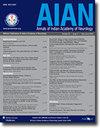1型Wolfram综合征的新表现为颅内出血和纵向广泛横断面脊髓炎:神经影像学和血管造影结果。
IF 1.9
4区 医学
Q3 CLINICAL NEUROLOGY
引用次数: 0
摘要
摘要:Wolfram综合征(WS)是一种罕见的遗传性神经退行性疾病,以糖尿病、视神经萎缩、尿崩症、感音神经性听力损失为主要特征,并伴有多种系统性表现。晚期病例表现为广泛的脑萎缩。虽然出血倾向在2型WS (WS2)中并不常见,但有一种独特的出血倾向是WS2独有的,在1型WS (WS1)中没有记录。关于该综合征的各种神经系统表现存在广泛的文献记录;然而,到目前为止,没有报道提到颅内出血,这在这种情况下是罕见的。本文章由计算机程序翻译,如有差异,请以英文原文为准。
Novel Presentation of Type 1 Wolfram Syndrome as Intracranial Hemorrhage and Longitudinally Extensive Transverse Myelitis: Neuroimaging and Angiographic Findings.
Abstract: Wolfram syndrome (WS), a rare genetic neurodegenerative condition, is primarily characterized by diabetes mellitus, optic atrophy, diabetes insipidus, and sensorineural hearing loss, along with diverse systemic manifestations. Late-stage cases exhibit widespread brain atrophy. While bleeding tendencies are not commonly observed in Type 2 WS (WS2), there is a distinctive bleeding tendency that is exclusive to WS2, with no documented occurrences in Type 1 WS (WS1). Extensive documentation exists regarding various neurologic manifestations of this syndrome; however, as of now, there is no reported mention of intracranial hemorrhage, a rarity within this condition.
求助全文
通过发布文献求助,成功后即可免费获取论文全文。
去求助
来源期刊

Annals of Indian Academy of Neurology
Nervous System Diseases-
CiteScore
2.20
自引率
11.80%
发文量
293
审稿时长
29 weeks
期刊介绍:
The journal has a clinical foundation and has been utilized most by clinical neurologists for improving the practice of neurology. While the focus is on neurology in India, the journal publishes manuscripts of high value from all parts of the world. Journal publishes reviews of various types, original articles, short communications, interesting images and case reports. The journal respects the scientific submission of its authors and believes in following an expeditious double-blind peer review process and endeavors to complete the review process within scheduled time frame. A significant effort from the author and the journal perhaps enables to strike an equilibrium to meet the professional expectations of the peers in the world of scientific publication. AIAN believes in safeguarding the privacy rights of human subjects. In order to comply with it, the journal instructs all authors when uploading the manuscript to also add the ethical clearance (human/animals)/ informed consent of subject in the manuscript. This applies to the study/case report that involves animal/human subjects/human specimens e.g. extracted tooth part/soft tissue for biopsy/in vitro analysis.
 求助内容:
求助内容: 应助结果提醒方式:
应助结果提醒方式:


